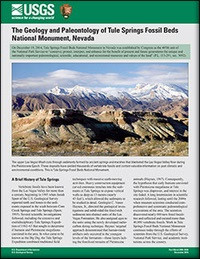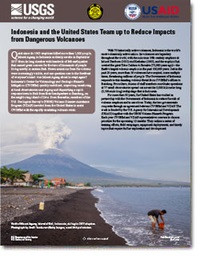
Product Details
- Product Number
- 534219
- Series
- FS-2018-3038
- Scale
- NO SCALE
- Alternate ID
- FS-2018-3038
- Authors
- ERIC SCOTT
- Version Date
- 12/01/2018
- Countries
- USA
- Media
- WEB ONLY
- Format
- WEB ONLY
Additional Details
- Description
-
The geology and paleontology of Tule Springs Fossil Beds National Monument, Nevada
This product is not available for order, it can only be downloaded from here (click on image) or within the Publications Warehouse at https://pubs.er.usgs.gov/publication/fs20183038
First posted December 20, 2018
For additional information, contact:
Director, Geosciences and Environmental Change Science Center
http://gec.cr.usgs.gov/
U.S. Geological Survey
Box 25046, MS-980
Denver, CO 80225-0046
Abstract
On December 19, 2014, Tule Springs Fossil Beds National Monument, located in the Las Vegas Valley of southern Nevada, was established by Congress as the 405th unit of the National Park Service to “conserve, protect, interpret, and enhance for the benefit of present and future generations the unique and nationally important paleontological, scientific, educational, and recreational resources and values of the land” (P.L. 113-291, sec. 3092). Vertebrate fossils have been known from the region for more than a century, and recent work has established the Tule Springs local fauna as one of the most significant Pleistocene vertebrate faunas in the American Southwest. The sedimentary sequence that entombs the fossils represents a paleohydrologic system that responded dynamically to abrupt changes in climate throughout the late Quaternary. Work in Tule Springs Fossil Beds National Monument continues today through the efforts of scientists from the U.S. Geological Survey, National Park Service, and academic institutions across the country.
- Survey Date
- 2018
- Print Date
- 2018
- Height In Inches
- 11.000
- Length In Inches
- 8.500
- Languages
- English




